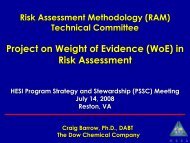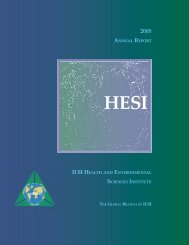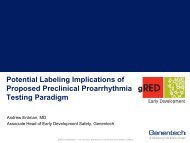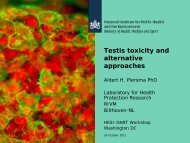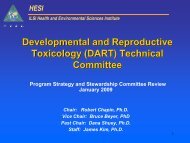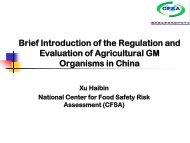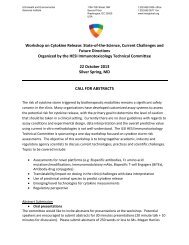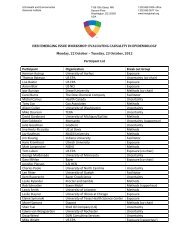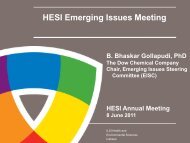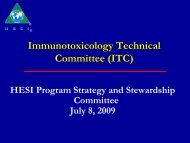How are the Possible Effects of Paternal Drug Exposure on ...
How are the Possible Effects of Paternal Drug Exposure on ...
How are the Possible Effects of Paternal Drug Exposure on ...
You also want an ePaper? Increase the reach of your titles
YUMPU automatically turns print PDFs into web optimized ePapers that Google loves.
<str<strong>on</strong>g>How</str<strong>on</strong>g> <str<strong>on</strong>g>are</str<strong>on</strong>g> <str<strong>on</strong>g>the</str<strong>on</strong>g> <str<strong>on</strong>g>Possible</str<strong>on</strong>g> <str<strong>on</strong>g>Effects</str<strong>on</strong>g> <str<strong>on</strong>g>of</str<strong>on</strong>g> <str<strong>on</strong>g>Paternal</str<strong>on</strong>g> <str<strong>on</strong>g>Drug</str<strong>on</strong>g><br />
<str<strong>on</strong>g>Exposure</str<strong>on</strong>g> <strong>on</strong> Pregnancy Outcome Addressed<br />
during <str<strong>on</strong>g>Drug</str<strong>on</strong>g> Development?<br />
Teratology Society<br />
San Diego, June 2011<br />
Jane Stewart MRCVS PhD<br />
AstraZeneca<br />
Pharmaceuticals<br />
On behalf <str<strong>on</strong>g>of</str<strong>on</strong>g> HESI-DART<br />
ILSI Health and<br />
Envir<strong>on</strong>mental Sciences<br />
Institute
Setting <str<strong>on</strong>g>the</str<strong>on</strong>g> scene:<br />
C<strong>on</strong>tent<br />
•Pre clinical trial package<br />
•Rodent mating study<br />
opti<strong>on</strong>s<br />
•Clinical trials sequelae<br />
•Areas <str<strong>on</strong>g>of</str<strong>on</strong>g> uncertainty<br />
Disclosure<br />
The presenter works for AstraZeneca<br />
Pharmaceuticals which may pose a c<strong>on</strong>flict <str<strong>on</strong>g>of</str<strong>on</strong>g><br />
interest. The original research in this<br />
presentati<strong>on</strong> was funded by AstraZeneca<br />
ILSI Health and<br />
Envir<strong>on</strong>mental Sciences<br />
Institute
Pre First Time in Man: Genetic Toxicity Tests<br />
Bacterial Reverse<br />
Mutati<strong>on</strong> (Ames) Test<br />
Bacteria (2/5 strains) removed from<br />
freezer and incubated shaking (37 o C)<br />
overnight<br />
Serial diluti<strong>on</strong> <str<strong>on</strong>g>of</str<strong>on</strong>g> test<br />
compound<br />
INCUBATOR<br />
&<br />
+<br />
/<br />
-<br />
Figure 1<br />
S<br />
9<br />
Metabolic activati<strong>on</strong> system<br />
(Rat liver S9 fracti<strong>on</strong> and c<str<strong>on</strong>g>of</str<strong>on</strong>g>actors)<br />
• Detect :<br />
• base pair substituti<strong>on</strong>s, frameshifts,<br />
transiti<strong>on</strong>s/transversi<strong>on</strong>s, small<br />
deleti<strong>on</strong>s, strand breaks, point<br />
mutati<strong>on</strong>s, clastogens & aneugens<br />
In Vitro Micr<strong>on</strong>ucleus assay<br />
An<br />
eu<br />
plo<br />
idy<br />
Plates<br />
incubated at<br />
37 o C for 3 days<br />
In vitro Mouse<br />
Lymphoma TK Assay<br />
In vivo B<strong>on</strong>e Marrow<br />
Micr<strong>on</strong>ucleus Test<br />
+ve ?<br />
Micr<strong>on</strong>ucle<br />
ated<br />
m<strong>on</strong><strong>on</strong>ucle<br />
ate cell<br />
Micr<strong>on</strong><br />
ucleat<br />
ed<br />
binucl<br />
eate<br />
cell<br />
Nucleus<br />
Micr<strong>on</strong>ucleus<br />
Cells dispensed<br />
at 1x10 7 /tube (3<br />
hr)<br />
+<br />
/<br />
-<br />
Serial diluti<strong>on</strong><br />
<str<strong>on</strong>g>of</str<strong>on</strong>g> test<br />
compound<br />
prep<str<strong>on</strong>g>are</str<strong>on</strong>g>d &<br />
cultures treated<br />
Incubated for -/+ 12 S9 days.<br />
Wells c<strong>on</strong>taining small &<br />
large mutant cl<strong>on</strong>es scored<br />
S<br />
9<br />
CO 2 INCUBATOR<br />
Cultures<br />
incubated at<br />
37 o C for 3<br />
hours<br />
2000 cells/well for mutant<br />
frequency determinati<strong>on</strong><br />
TFT<br />
Cultures<br />
washed,diluted to<br />
2x10 5 /mL&<br />
incubated 24 hr.<br />
Cultures counted,<br />
subbed to<br />
1.5x10 5 /mL&<br />
incubated for<br />
ano<str<strong>on</strong>g>the</str<strong>on</strong>g>r 24 hr<br />
Rats/mice dosed with<br />
compound, three c<strong>on</strong>cs, seven<br />
animals / group. Animals<br />
sacrificed 24 or 48 hours later<br />
Micr<strong>on</strong>ucleus<br />
Micr<strong>on</strong>uclei may be formed by loss <str<strong>on</strong>g>of</str<strong>on</strong>g> whole<br />
chromosome during divisi<strong>on</strong> or by chromosome<br />
breakage. The erythrocyte’s nucleus is extruded leaving<br />
any micr<strong>on</strong>uclei behind<br />
Healthy Volunteers v patients<br />
Mutant frequency<br />
calculated<br />
(number mutants<br />
per 10 -6 viable<br />
cells)<br />
Incubated for 8 days.<br />
Wells c<strong>on</strong>taining<br />
viable cl<strong>on</strong>es scored<br />
Cultures<br />
counted and<br />
plated into<br />
selective (with<br />
TFT) & n<strong>on</strong>selective<br />
medium<br />
1.6 cells/well for cl<strong>on</strong>ing<br />
efficiency determinati<strong>on</strong><br />
2000 cells analysed per animal, number<br />
<str<strong>on</strong>g>of</str<strong>on</strong>g> micr<strong>on</strong>ucleated immature<br />
erythrocytes scored<br />
• s<br />
B<strong>on</strong>e marrow cells spread <strong>on</strong>to<br />
slides. Slides fixed and stained<br />
(acridine orange)<br />
Femurs removed<br />
and b<strong>on</strong>e<br />
marrow aspirated<br />
Informed c<strong>on</strong>sent, & advice<br />
re c<strong>on</strong>dom use & procreati<strong>on</strong>
Pre FTiM: General Toxicity Tests<br />
ICH M3: Two species, minimum 2 weeks<br />
Sexually mature animals – usually dog & rat – + recovery groups (preferably)<br />
Organ weights & histopathology (read in a stage-aw<str<strong>on</strong>g>are</str<strong>on</strong>g> manner)
ICH M3: Why <str<strong>on</strong>g>are</str<strong>on</strong>g> clinical trials in men<br />
permitted prior to completi<strong>on</strong> <str<strong>on</strong>g>of</str<strong>on</strong>g> reprotox package?<br />
Histopathology is paramount!<br />
Takayama S et al (1995) : A collaborative study in Japan <strong>on</strong> optimal treatment period and<br />
parameters for detecti<strong>on</strong> <str<strong>on</strong>g>of</str<strong>on</strong>g> male fertility disorders induced by drugs in rats. J. Am.Coll. Toxicol. 14(4)<br />
(1995), 266-292.<br />
Ulbrich, B.; Palmer, A.K. (1995), : Detecti<strong>on</strong> <str<strong>on</strong>g>of</str<strong>on</strong>g> effects <strong>on</strong> male reproducti<strong>on</strong> - A literature survey. J.<br />
Am. Coll. Toxicol. 14(4) 293-327.<br />
Sakai T et al (2000): Collaborative work to evaluate toxicity <strong>on</strong> male reproductive organs by 2-week<br />
repeated dose toxicity studies in rats. Overview <str<strong>on</strong>g>of</str<strong>on</strong>g> <str<strong>on</strong>g>the</str<strong>on</strong>g> studies, J. Tox, Sci. 25, 1-21<br />
Mangelsdorf I & Buschmann J (2002) Extrapolati<strong>on</strong> from Results<br />
<str<strong>on</strong>g>of</str<strong>on</strong>g> Animal Studies to Humans for <str<strong>on</strong>g>the</str<strong>on</strong>g> Endpoint Male Fertility<br />
German Federal Institute for Occupati<strong>on</strong>al Safety and Health<br />
Any as yet undetected adverse effect assumed to be reversible<br />
and manageable via request to avoid procreati<strong>on</strong>?<br />
Adverse effect in mating study assumed unlikely?
Reliance <strong>on</strong> Histopath for FTiM:<br />
Is <str<strong>on</strong>g>the</str<strong>on</strong>g>re a problem?<br />
HESI DART survey – 16 pharma<br />
• Sasaki et al BDR (Submitted) “Incidence & nature <str<strong>on</strong>g>of</str<strong>on</strong>g> testicular<br />
toxicity findings in pharmaceutical development”<br />
• Sexually mature animals – comm<strong>on</strong> but not universal<br />
• 2 examples <str<strong>on</strong>g>of</str<strong>on</strong>g> testes lesi<strong>on</strong>s 1st detected in studies > 1 m<strong>on</strong>th<br />
• 2 nd species <strong>on</strong>ly n=3!<br />
ILSI Health and<br />
Envir<strong>on</strong>mental Sciences<br />
Institute<br />
6
ICH S5 (R2) 2005: Required for Phase III<br />
Fertility & early embry<strong>on</strong>ic development study<br />
Males pre-mating<br />
dosed (2-)4 weeks<br />
1:1 mating & separate M & F when mated.<br />
C<strong>on</strong>tinue to dose M until F <str<strong>on</strong>g>are</str<strong>on</strong>g> necropsied<br />
Day 6<br />
stop dosing F<br />
Females dosed 2<br />
wks pre-mating<br />
to implantati<strong>on</strong><br />
Precoital interval<br />
~Day13 mid-gestati<strong>on</strong> necropsy,<br />
count CL, live & dead implants<br />
Testes weight, histopath, OPTIONAL Fetal morphology – NOT DONE<br />
Sperm analysis – for cause<br />
Toxicokinetics – opti<strong>on</strong>al
AZ approach : Male Fertility<br />
Assessed within 3 or 6 m<strong>on</strong>th general tox study<br />
Males dosed ~9 weeks<br />
pre-mating, starting<br />
when 5-6* weeks<br />
1:1 mating<br />
Recovery<br />
UNDOSED Females<br />
Remate as needed,<br />
using recovery males if included<br />
Precoital interval<br />
~Day13 “headcount” necropsy,<br />
count CL, live & dead implants<br />
General tox design full dataset: TK, clin path, full tissue list.<br />
Lose 1 week food c<strong>on</strong>sumpti<strong>on</strong> data. No c<strong>on</strong>fusi<strong>on</strong> over affected gender!<br />
* Choose ~ 5 weeks start age to support paeds indicati<strong>on</strong>s
Undosed females & General Tox test males:<br />
% mated within 7 nights (21 studies, 1684 females)<br />
Number<br />
Of Studies<br />
90 * 95* 97 98 99 100<br />
ILSI Health and<br />
Envir<strong>on</strong>mental Sciences<br />
Institute<br />
*CRO with slight smear technique issue!<br />
9
Pregnancy rates in c<strong>on</strong>trol females mated to<br />
c<strong>on</strong>trol males in general tox studies<br />
98% chance <str<strong>on</strong>g>of</str<strong>on</strong>g> have > or = 15/16 pregnant in a c<strong>on</strong>trol group <str<strong>on</strong>g>of</str<strong>on</strong>g> 16<br />
ILSI Health and<br />
Envir<strong>on</strong>mental Sciences<br />
Institute<br />
10
Live embryo numbers in c<strong>on</strong>trol<br />
Wistars mated to General Tox males<br />
Live embryos<br />
ILSI Health and<br />
Envir<strong>on</strong>mental Sciences<br />
Institute<br />
11
Power (%) to detect reducti<strong>on</strong>s in number <str<strong>on</strong>g>of</str<strong>on</strong>g> live<br />
embryos – using c<strong>on</strong>trol data simulati<strong>on</strong>s<br />
P Jarvis, T Mitchard, J Stewart (in progress)<br />
C<strong>on</strong>firming adequacy <str<strong>on</strong>g>of</str<strong>on</strong>g> n = 15 /16 to assess male fertility<br />
ILSI Health and<br />
Envir<strong>on</strong>mental Sciences<br />
Institute<br />
12
<str<strong>on</strong>g>How</str<strong>on</strong>g> <str<strong>on</strong>g>are</str<strong>on</strong>g> <str<strong>on</strong>g>the</str<strong>on</strong>g> <str<strong>on</strong>g>Possible</str<strong>on</strong>g> <str<strong>on</strong>g>Effects</str<strong>on</strong>g> <str<strong>on</strong>g>of</str<strong>on</strong>g> <str<strong>on</strong>g>Paternal</str<strong>on</strong>g> <str<strong>on</strong>g>Drug</str<strong>on</strong>g><br />
<str<strong>on</strong>g>Exposure</str<strong>on</strong>g> <strong>on</strong> Pregnancy Outcome Addressed<br />
during <str<strong>on</strong>g>Drug</str<strong>on</strong>g> Development?<br />
•Pre FTiM package<br />
•Rodent mating study opti<strong>on</strong>s<br />
•Clinical trials sequelae<br />
•Areas <str<strong>on</strong>g>of</str<strong>on</strong>g> uncertainty<br />
ILSI Health and<br />
Envir<strong>on</strong>mental Sciences<br />
Institute
<str<strong>on</strong>g>How</str<strong>on</strong>g> do preclinical data influence clinical trials?<br />
2009 Informal Industry Survey re male c<strong>on</strong>tracepti<strong>on</strong><br />
• Informal PhRMA survey (T<strong>on</strong>y DeLise) – 9 resp<strong>on</strong>dent companies<br />
• 5/9 did NOT have written policy, but all react to male reprotox signals<br />
with advice <strong>on</strong> procreati<strong>on</strong>.<br />
• Is c<strong>on</strong>dom use <str<strong>on</strong>g>the</str<strong>on</strong>g> default? 8/9 – NO<br />
2 companies - issue driven eg genetic toxicants or teratogens<br />
• 3/ 9 reported requests for seminal fluid c<strong>on</strong>centrati<strong>on</strong>s <str<strong>on</strong>g>of</str<strong>on</strong>g> teratogens<br />
• 6/9 reported requests for use <str<strong>on</strong>g>of</str<strong>on</strong>g> male c<strong>on</strong>doms based ei<str<strong>on</strong>g>the</str<strong>on</strong>g>r <strong>on</strong> lack<br />
<str<strong>on</strong>g>of</str<strong>on</strong>g> EFD data or evidence <str<strong>on</strong>g>of</str<strong>on</strong>g> teratogenicity<br />
ILSI Health and<br />
Envir<strong>on</strong>mental Sciences<br />
Institute<br />
14
Areas <str<strong>on</strong>g>of</str<strong>on</strong>g> regulatory & clinical uncertainty<br />
Male procreati<strong>on</strong> and use <str<strong>on</strong>g>of</str<strong>on</strong>g> c<strong>on</strong>doms<br />
• C<strong>on</strong>fusi<strong>on</strong>: risk to WCBP/ pregnancy from exposure to drug in ejaculate<br />
– In absence <str<strong>on</strong>g>of</str<strong>on</strong>g> EFD data, should men use c<strong>on</strong>dom if partner is not using c<strong>on</strong>tracepti<strong>on</strong>?<br />
– For compounds deemed “high risk” <str<strong>on</strong>g>of</str<strong>on</strong>g> causing fetal harm, is it justified to c<strong>on</strong>tinue to ask<br />
men to use c<strong>on</strong>dom ? What data <str<strong>on</strong>g>are</str<strong>on</strong>g> needed to remove need for c<strong>on</strong>dom?<br />
– (If we believe <str<strong>on</strong>g>the</str<strong>on</strong>g>re is risk <str<strong>on</strong>g>of</str<strong>on</strong>g> sufficient absorpti<strong>on</strong> to affect fetus, should we be c<strong>on</strong>cerned<br />
re. o<str<strong>on</strong>g>the</str<strong>on</strong>g>r undesirable PD affects in sexual partners <str<strong>on</strong>g>of</str<strong>on</strong>g> male patients?)<br />
• C<strong>on</strong>fusi<strong>on</strong> : management <str<strong>on</strong>g>of</str<strong>on</strong>g> potential for male mediated effects<br />
– If genotox negative and no effects <strong>on</strong> testes path, until mating studies <str<strong>on</strong>g>are</str<strong>on</strong>g> completed and<br />
proven negative, should men be required to avoid procreati<strong>on</strong> ? And for how l<strong>on</strong>g?<br />
– What if mating studies <str<strong>on</strong>g>are</str<strong>on</strong>g>n’t feasible in a relevant species?<br />
ILSI Health and<br />
Envir<strong>on</strong>mental Sciences<br />
Institute<br />
15
Areas <str<strong>on</strong>g>of</str<strong>on</strong>g> regulatory & clinical uncertainty<br />
Instructi<strong>on</strong> to avoid procreati<strong>on</strong> ≠ c<strong>on</strong>dom use<br />
ILSI Health and<br />
Envir<strong>on</strong>mental Sciences<br />
Institute<br />
“XXX may affect your fertility.” Or “<str<strong>on</strong>g>the</str<strong>on</strong>g> effect <str<strong>on</strong>g>of</str<strong>on</strong>g> XXX <strong>on</strong> fertility is unknown”<br />
16<br />
Do not attempt to fa<str<strong>on</strong>g>the</str<strong>on</strong>g>r children while taking XXX or for YY m<strong>on</strong>ths after stoppingTx”.
Areas <str<strong>on</strong>g>of</str<strong>on</strong>g> regulatory & clinical uncertainty<br />
Durati<strong>on</strong> <str<strong>on</strong>g>of</str<strong>on</strong>g> restricti<strong>on</strong> <strong>on</strong> procreati<strong>on</strong> / c<strong>on</strong>dom use<br />
• MHRA (UK) guidance:<br />
• C<strong>on</strong>traceptive requirements for male subjects with partners <str<strong>on</strong>g>of</str<strong>on</strong>g><br />
childbearing potential should be included in <str<strong>on</strong>g>the</str<strong>on</strong>g> protocol where needed.<br />
These requirements should also extend to a suitable period after <str<strong>on</strong>g>the</str<strong>on</strong>g> last<br />
dose <str<strong>on</strong>g>of</str<strong>on</strong>g> study medicati<strong>on</strong> (e.g., a whole spermatogenic cycle or five halflives)<br />
and should be based up<strong>on</strong> <str<strong>on</strong>g>the</str<strong>on</strong>g> availability and results <str<strong>on</strong>g>of</str<strong>on</strong>g> reproductive<br />
toxicity data.<br />
• Above is interpreted in different ways.<br />
ILSI Health and<br />
Envir<strong>on</strong>mental Sciences<br />
Institute<br />
17
Areas <str<strong>on</strong>g>of</str<strong>on</strong>g> regulatory & clinical uncertainty<br />
C<strong>on</strong>dom use when partner is/may be pregnant<br />
• MHRA (UK) guidance:<br />
• Where <str<strong>on</strong>g>the</str<strong>on</strong>g>re is a risk <str<strong>on</strong>g>of</str<strong>on</strong>g> drug secreti<strong>on</strong> through <str<strong>on</strong>g>the</str<strong>on</strong>g> ejaculate, male<br />
subjects whose partners <str<strong>on</strong>g>are</str<strong>on</strong>g> pregnant should use c<strong>on</strong>doms for <str<strong>on</strong>g>the</str<strong>on</strong>g><br />
durati<strong>on</strong> <str<strong>on</strong>g>of</str<strong>on</strong>g> <str<strong>on</strong>g>the</str<strong>on</strong>g> study and for a suitable time afterwards (e.g., five halflives).<br />
This is to ensure that <str<strong>on</strong>g>the</str<strong>on</strong>g> fetus is not exposed to <str<strong>on</strong>g>the</str<strong>on</strong>g> IMP through<br />
vaginal absorpti<strong>on</strong>.”<br />
• Above (unintenti<strong>on</strong>ally?) independent <str<strong>on</strong>g>of</str<strong>on</strong>g> animal EFD study results<br />
• <str<strong>on</strong>g>Drug</str<strong>on</strong>g> likely to be detectable in ejaculate - does amount matter?<br />
ILSI Health and<br />
Envir<strong>on</strong>mental Sciences<br />
Institute<br />
18
Areas <str<strong>on</strong>g>of</str<strong>on</strong>g> scientific uncertainty:<br />
Risk <str<strong>on</strong>g>of</str<strong>on</strong>g> embry<str<strong>on</strong>g>of</str<strong>on</strong>g>etal harm from drug exposure in ejaculate<br />
• Absorpti<strong>on</strong> from vagina (& caudal rectum) avoids “1 st pass” metabolism.<br />
• Klemmt & Scialli (2005) BDR 74:119-131 “The Transport <str<strong>on</strong>g>of</str<strong>on</strong>g> Chemicals<br />
in Semen” . <str<strong>on</strong>g>Drug</str<strong>on</strong>g> c<strong>on</strong>centrati<strong>on</strong> in seminal fluid < x10 blood<br />
• Assume ejaculate c<strong>on</strong>c is x10 blood & 100% bioavailability & daily<br />
sexual intercourse with pregnant partner, predicted c<strong>on</strong>centrati<strong>on</strong>s in<br />
female <str<strong>on</strong>g>are</str<strong>on</strong>g> usually
Product informati<strong>on</strong>: US versus UK<br />
Bosentan: endo<str<strong>on</strong>g>the</str<strong>on</strong>g>lin antag<strong>on</strong>ist<br />
• US<br />
• Can cause birth defects<br />
• UK<br />
• Can cause birth defects<br />
• Human - reduced sperm counts<br />
• Animal - testes atrophy in l<strong>on</strong>g<br />
term studies<br />
• Fertility study OK<br />
• No restricti<strong>on</strong> <strong>on</strong> male patient<br />
procreati<strong>on</strong> or requirement to<br />
wear c<strong>on</strong>doms<br />
• Male rat fertility study OK<br />
• No restricti<strong>on</strong> <strong>on</strong> male patient<br />
procreati<strong>on</strong> or requirement to<br />
wear c<strong>on</strong>doms<br />
(No info <strong>on</strong> semen c<strong>on</strong>centrati<strong>on</strong>s in ei<str<strong>on</strong>g>the</str<strong>on</strong>g>r )<br />
ILSI Health and<br />
Envir<strong>on</strong>mental Sciences<br />
Institute<br />
20
Future state?<br />
Genotoxic?<br />
No<br />
Testicular<br />
toxicant?<br />
YES<br />
YES<br />
1. Wear c<strong>on</strong>dom during trial<br />
and for x5 half life washout period<br />
2. Avoid procreati<strong>on</strong> for (6) m<strong>on</strong>ths<br />
3. C<strong>on</strong>sider sperm banking<br />
Avoid procreati<strong>on</strong> for (3) m<strong>on</strong>ths<br />
(C<strong>on</strong>sider sperm banking)<br />
No<br />
Mating study<br />
negative ?<br />
NO or UNKNOWN<br />
Avoid procreati<strong>on</strong> during trial and<br />
for (2) weeks afterwards<br />
21
HESI DART <str<strong>on</strong>g>Drug</str<strong>on</strong>g>s in Human Semen<br />
Team & Acknowledgments<br />
•AZ Male Fertility Data Modelling:<br />
Philip Jarvis and Terri Mitchard<br />
•HESI DART Steering Team<br />
Graham Bailey<br />
Kimberly Bens<strong>on</strong><br />
Bruce Beyer<br />
Bill Breslin<br />
Gary Chellman<br />
Ruediger Cordts<br />
Liz Davids<strong>on</strong><br />
T<strong>on</strong>y DeLise<br />
Wafa Harrouk<br />
Kok Wah Hew<br />
Julia Hui<br />
Johns<strong>on</strong> & Johns<strong>on</strong><br />
U.S. FDA<br />
san<str<strong>on</strong>g>of</str<strong>on</strong>g>i-aventis<br />
Lilly<br />
Charles River Labs<br />
Boehringer-Ingelheim<br />
C<strong>on</strong>sultant (MHRA)<br />
san<str<strong>on</strong>g>of</str<strong>on</strong>g>i-aventis<br />
U.S. FDA<br />
Takeda<br />
Celgene<br />
Jim Kim<br />
HESI<br />
Larry Leshin U.S. FDA<br />
Jimmy McBlane MHRA<br />
Graeme M<str<strong>on</strong>g>of</str<strong>on</strong>g>fat Amgen<br />
Christine Nguyen U.S. FDA<br />
Anth<strong>on</strong>y Scialli Tetra Tech Sciences<br />
George Scott Amgen<br />
Jane Stewart AstraZeneca<br />
Kary Thomps<strong>on</strong> Bristol-Myers Squibb<br />
Ulla Wandel-Liminga Sweden Medical Products Agency<br />
ILSI Health and<br />
Envir<strong>on</strong>mental Sciences<br />
Institute<br />
22



